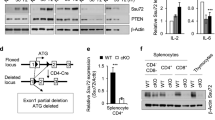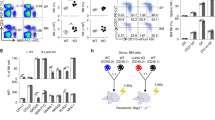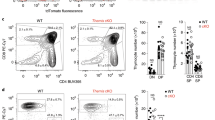Key Points
-
Mutations that affect the adaptor molecule SLAM-associated protein (SAP) lead to the genetic disorder X-linked lymphoproliferative syndrome (XLP), which is characterized by severe, often fulminant infections with Epstein–Barr virus, lymphoproliferative disorders (including lymphomas) and dysgammaglobulinaemia that can progress to hypogammaglobulinaemia.
-
SAP is required for signalling downstream of members of the signalling lymphocytic activation molecule (SLAM) family of immunomodulatory receptors.
-
Examination of humoral responses in SAP-deficient mice has shown impaired germinal-centre formation and severely reduced numbers of long-lived plasma cells and memory B cells. Similar findings have now been confirmed in humans with XLP.
-
New findings from in vivo intravital imaging have revealed that SAP-deficient CD4+ T cells show normal adhesion to and activation by dendritic cells but impaired adhesion to activated B cells. These findings suggest that SAP-deficient CD4+ T cells cannot deliver contact-dependent signals that are required for B-cell proliferation and germinal-centre formation, providing new insights into the defects associated with SAP deficiency.
-
SAP is also required in mice for the development of natural killer T (NKT) cells and other innate T-cell lineages that are selected by haematopoietic cells in the thymus (specifically, innate T-cell populations that are selected by double-positive thymocytes). A lack of NKT cells has also been confirmed in patients with XLP. Whether and how these effects on innate T-cell lineages affect the phenotypes of XLP are not clear, but patients with a variant of XLP that is caused by mutations that affect a different gene also lack NKT cells.
-
These findings suggest that SAP and SLAM family members affect the lymphocyte interactions that are required for development and differentiation, and raise the question of how defective lymphocyte–lymphocyte adhesion contributes to phenotypes that are associated with XLP.
Abstract
Mutations that affect the adaptor molecule SLAM-associated protein (SAP) underlie the primary immunodeficiency disease X-linked lymphoproliferative syndrome. SAP is required for mediating signals from members of the signalling lymphocytic activation molecule (SLAM) family of immunomodulatory receptors. Recent data have highlighted a role for SAP in the development of innate-like T-cell lineages, including natural killer T cells, and in the regulation of the interactions between B cells and T cells that are required for germinal-centre formation and long-term humoral immunity. These data have revealed that SLAM family members and SAP have crucial roles in regulating lymphocyte interactions and adhesion, which are required for the normal development, homeostasis and function of the immune system.
This is a preview of subscription content, access via your institution
Access options
Subscribe to this journal
Receive 12 print issues and online access
$209.00 per year
only $17.42 per issue
Buy this article
- Purchase on Springer Link
- Instant access to full article PDF
Prices may be subject to local taxes which are calculated during checkout




Similar content being viewed by others
References
Calpe, S. et al. The SLAM and SAP gene families control innate and adaptive immune responses. Adv. Immunol. 97, 177–250 (2008).
Ma, C. S., Nichols, K. E. & Tangye, S. G. Regulation of cellular and humoral immune responses by the SLAM and SAP families of molecules. Annu. Rev. Immunol. 25, 337–379 (2007).
Veillette, A. Immune regulation by SLAM family receptors and SAP-related adaptors. Nature Rev. Immunol. 6, 56–66 (2006).
Claus, M., Meinke, S., Bhat, R. & Watzl, C. Regulation of NK cell activity by 2B4, NTB-A and CRACC. Front. Biosci. 13, 956–965 (2008).
Crotty, S., Kersh, E. N., Cannons, J., Schwartzberg, P. L. & Ahmed, R. SAP is required for generating long-term humoral immunity. Nature 421, 282–287 (2003). This paper provides the first evidence for a defect in germinal-centre formation, accompanied by decreased numbers of memory B cells and long-lived plasma cells in SAP-deficient mice. These findings paved the way for the recognition of similar defects in patients with XLP. The study also provided the first evidence for a T-cell–intrinsic contribution to these defects.
Hron, J. D., Caplan, L., Gerth, A. J., Schwartzberg, P. L. & Peng, S. L. SH2D1A regulates T-dependent humoral autoimmunity. J. Exp. Med. 200, 261–266 (2004).
Ma, C. S. et al. Impaired humoral immunity in X-linked lymphoproliferative disease associated with defective IL-10 production by CD4+ T cells. J. Clin. Invest. 115, 1049–1059 (2005).
Ma, C. S. et al. Selective generation of functional somatically mutated IgM+CD27+, but not Ig isotype-switched, memory B cells in X-linked lymphoproliferative disease. J. Clin. Invest. 116, 322–331 (2006).
Morra, M. et al. Defective B cell responses in the absence of SH2D1A. Proc. Natl Acad. Sci. USA 102, 4819–4823 (2005).
Chung, B., Aoukaty, A., Dutz, J., Terhorst, C. & Tan, R. Signaling lymphocytic activation molecule-associated protein controls NKT cell functions. J. Immunol. 174, 3153–3157 (2005).
Nichols, K. E. et al. Regulation of NKT cell development by SAP, the protein defective in XLP. Nature Med. 11, 340–345 (2005).
Pasquier, B. et al. Defective NKT cell development in mice and humans lacking the adapter SAP, the X-linked lymphoproliferative syndrome gene product. J. Exp. Med. 201, 695–701 (2005).
Cannons, J. L. et al. SAP regulates TH2 differentiation and PKC-θ-mediated activation of NF-κB1. Immunity 21, 693–706 (2004).
Czar, M. J. et al. Altered lymphocyte responses and cytokine production in mice deficient in the X-linked lymphoproliferative disease gene SH2D1A/DSHP/SAP. Proc. Natl Acad. Sci. USA 98, 7449–7454 (2001).
Davidson, D. et al. Genetic evidence linking SAP, the X-linked lymphoproliferative gene product, to Src-related kinase FynT in TH2 cytokine regulation. Immunity 21, 707–717 (2004).
Wu, C. et al. SAP controls T cell responses to virus and terminal differentiation of TH2 cells. Nature Immunol. 2, 410–413 (2001).
Sayos, J. et al. The X-linked lymphoproliferative-disease gene product SAP regulates signals induced through the co-receptor SLAM. Nature 395, 462–469 (1998). This paper was one of three papers showing that mutations of SAP are associated with XLP. This study further shows that SAP interacts with the cytoplasmic tail of SLAM, providing the first clues to SAP function.
Chan, A. Y., Westcott, J. M., Mooney, J. M., Wakeland, E. K. & Schatzle, J. D. The role of the SAP and SLAM family in autoimmunity. Curr. Opin. Immunol. 18, 656–664 (2006).
Chan, B. et al. SAP couples Fyn to SLAM immune receptors. Nature Cell Biol. 5, 155–160 (2003).
Latour, S. et al. Regulation of SLAM-mediated signal transduction by SAP, the X-linked lymphoproliferative gene product. Nature Immunol. 2, 681–690 (2001). This paper shows that SAP recruits FYN to phosphorylate SLAM family members, suggesting that SAP can function as an adaptor molecule.
Latour, S. et al. Binding of SAP SH2 domain to FynT SH3 domain reveals a novel mechanism of receptor signalling in immune regulation. Nature Cell Biol. 5, 149–154 (2003).
Mikhalap, S. V. et al. CDw150 associates with Src-homology 2-containing inositol phosphatase and modulates CD95-mediated apoptosis. J. Immunol. 162, 5719–5727 (1999).
Zhong, M.-C. & Veillette, A. Control of T lymphocyte signaling by Ly108, a signaling lymphocytic activation molecule receptor implicated in autoimmunity. J. Biol. Chem. 283, 19255–19264 (2008).
Gu, C. et al. The X-linked lymphoproliferative disease gene product SAP associates with PAK-interacting exchange factor and participates in T cell activation. Proc. Natl Acad. Sci. USA 103, 14447–14452 (2006).
Cannons, J. L. et al. SAP regulates T cell-mediated help for humoral immunity by a mechanism distinct from cytokine regulation. J. Exp. Med. 203, 1551–1565 (2006).
McCausland, M. M. et al. SAP regulation of follicular helper CD4 T cell development and humoral immunity is independent of SLAM and Fyn kinase. J. Immunol. 178, 817–828 (2007). This paper, along with reference 25, provides the first evidence that germinal-centre defects that are associated with SAP deficiency result from a distinct signalling pathway that depends less on the ability of SAP to recruit molecules, including FYN, through its arginine 78 motif.
Veillette, A. et al. SAP expression in T cells, not in B cells, is required for humoral immunity. Proc. Natl Acad. Sci. USA 105, 1273–1278 (2008).
Berg, L. J. Signalling through the TEC kinases regulates conventional versus innate CD8+ T-cell development. Nature Rev. Immunol. 7, 479–485 (2007).
Gadue, P., Morton, N. & Stein, P. L. The Src family tyrosine kinase Fyn regulates natural killer T cell development. J. Exp. Med. 190, 1189–1196 (1999).
Eberl, G., Lowin-Kropf, B. & MacDonald, H. R. NKT cell development is selectively impaired in Fyn-deficient mice. J. Immunol. 163, 4091–4094 (1999).
Borowski, C. & Bendelac, A. Signaling for NKT cell development: the SAP–FynT connection. J. Exp. Med. 201, 833–836 (2005).
Graham, D. B. et al. Ly9 (CD229)-deficient mice exhibit T cell defects yet do not share several phenotypic characteristics associated with SLAM- and SAP-deficient mice. J. Immunol. 176, 291–300 (2005).
Griewank, K. et al. Homotypic interactions mediated by Slamf1 and Slamf6 receptors control NKT cell lineage development. Immunity 27, 751–762 (2007). This paper examines the requirement for SLAM family members in NKT-cell development. Using mixed bone-marrow chimeras, the authors elegantly show that NKT-cell development requires both LY108 and SLAM.
Wang, N. et al. The cell surface receptor SLAM controls T cell and macrophage functions. J. Exp. Med. 199, 1255–1264 (2004).
Godthelp, B. C., van Eggermond, M. C., Van Tol, M. J., Vossen, J. M. & van den Elsen, P. J. T cell immune reconstitution after allogeneic bone marrow transplantation in bare lymphocyte syndrome. Human Immunol. 61, 898–907 (2000).
Klein, C. et al. Bone marrow transplantation in major histocompatibility complex class II deficiency: a single study of 19 patients. Blood 85, 580–587 (1995).
Choi, E. Y. et al. Thymocyte–thymocyte interaction for efficient positive selection and maturation of CD4 T cells. Immunity 23, 387–396 (2005).
Li, W. et al. An alternate pathway for CD4 T cell development: thymocyte-expressed MHC class II selects a distinct T cell population. Immunity 23, 375–386 (2005).
Li, W. et al. The SLAM-associated protein signaling pathway is required for development of CD4+ T cells selected by homotypic thymocyte interaction. Immunity 27, 763–774 (2007).
Atherly, L. O. et al. The Tec family tyrosine kinases Itk and Rlk regulate the development of conventional CD8+ T cells. Immunity 25, 79–91 (2006).
Broussard, C. et al. Altered development of CD8+ T cell lineages in mice deficient for the Tec kinases Itk and Rlk. Immunity 25, 93–104 (2006).
Dubois, S., Waldmann, T. A. & Muller, J. R. ITK and IL-15 support two distinct subsets of CD8+ T cells. Proc. Natl Acad. Sci. USA 103, 12075–12080 (2006).
Hu, J., Sahu, N., Walsh, E. & August, A. Memory phenotype CD8+ T cells with innate function selectively develop in the absence of active Itk. Eur. J. Immunol. 37, 2892–2899 (2007).
Horai, R. et al. Requirements for selection of conventional and innate T lymphocyte lineages. Immunity 27, 775–785 (2007).
Nunez-Cruz, S. et al. Differential requirement for the SAP–Fyn interaction during NK T cell development and function. J. Immunol. 181, 2311–2320 (2008).
Allen, C. D. C., Okada, T. & Cyster, J. G. Germinal-center organization and cellular dynamics. Immunity 27, 190–202 (2007).
Garside, P. et al. Visualization of specific B and T lymphocyte interactions in the lymph node. Science 281, 96–99 (1998).
Okada, T. et al. Antigen-engaged B cells undergo chemotaxis toward the T zone and form mobile conjugates with helper T cells. PLOS Biol. 3, 1047–1061 (2005).
Germain, R. N. et al. Making friends in out-of-the-way places: how cells of the immune system get together and how they conduct their business as revealed by intravital imaging. Immunol. Rev. 221, 163–181 (2008).
King, C., Tangye, S. G. & Mackay, C. R. T follicular helper (TFH) cells in normal and dysregulated immune responses. Annu. Rev. Immunol. 26, 741–766 (2008).
Vinuesa, C. G. et al. A RING-type ubiquitin ligase family member required to repress follicular helper T cells and autoimmunity. Nature 435, 452–458 (2005).
Nurieva, R. I. et al. Generation of T follicular helper cells is mediated by interleukin-21 but independent of T helper 1, 2 or 17 cell lineages. Immunity 29, 138–149 (2008).
Vogelzang, A. et al. A fundamental role for interleukin-21 in the generation of T follicular helper cells. Immunity 29, 127–137 (2008).
Chtanova, T. et al. T follicular helper cells express a distinct transcriptional profile, reflecting their role as non-Th1/Th2 effector cells that provide help for B cells. J. Immunol. 173, 68–78 (2004).
Kamperschroer, C., Dibble, J. P., Meents, D. L., Schwartzberg, P. L. & Swain, S. L. SAP is required for Th cell function and for immunity to influenza. J. Immunol. 177, 5317–5327 (2006).
Kamperschroer, C., Roberts, D. M., Zhang, Y., Weng, N.-P. & Swain, S. L. SAP enables T cells to help B cells by a mechanism distinct from Th cell programming or CD40 ligand regulation. J. Immunol. 181, 3994–4003 (2008).
Al-Alem, U. et al. Impaired Ig class switch in mice deficient for the X-linked lymphoproliferative disease gene sap. Blood 106, 2069–2075 (2005).
Ozaki, K. et al. A critical role for IL-21 in regulating immunoglobulin production. Science 298, 1630–1634 (2002).
Qi, H., Cannons, J. L., Klauschen, F., Schwartzberg, P. L. & Germain, R. N. SAP-controlled T–B cell interactions underlies germinal centre formation. Nature 455, 764–769 (2008). This paper uses an in vivo imaging approach to show that SAP-deficient CD4+ T cells can adhere to and be activated by DCs normally, but have a selective defect in their adhesion to B cells. These findings provide new insight into the nature of the defects in germinal-centre formation that are associated with SAP deficiency.
Ebert, L. M., Horn, M. P., Lang, A. B. & Moser, B. B cells alter the phenotype and function of follicular-homing CXCR5+ T cells. Eur. J. Immunol. 34, 3562–3571 (2004).
Cao, E. et al. NTB-A receptor crystal structure: insights into homophilic interactions in the signaling lymphocytic activation molecule receptor family. Immunity 25, 559–570 (2006).
Yan, Q. et al. Structure of CD84 provides insight into SLAM family function. Proc. Natl Acad. Sci. USA 104, 10583–10588 (2007).
Nanda, N. et al. Platelet aggregation induces platelet aggregate stability via SLAM family receptor signaling. Blood 106, 3028–3034 (2005).
Sanzone, S. et al. SLAM-associated protein deficiency causes imbalanced early signal transduction and blocks downstream activation in T cells from X-linked lymphoproliferative disease patients. J. Biol. Chem. 278, 29593–29599 (2003).
Brossard, C. et al. Multifocal structure of the T cell-dendritic cell synaspe. Eur. J. Immunol. 35, 1741–1753 (2005).
Rigaud, S. et al. XIAP deficiency in humans causes an X-linked lymphoproliferative syndrome. Nature 444, 110–114 (2006).
Howie, D. et al. The SLAM family receptor Ly108 controls T cell and neutrophil functions. J. Immunol. 174, 5931–5935 (2005).
Acknowledgements
We acknowledge the contributions of the many investigators in the field and of the patients with XLP, and apologize to those that we could not cite owing to space limitations.
Author information
Authors and Affiliations
Corresponding author
Supplementary information
Supplementary Information, Movie 1
Sap−/− T cells form short-lived conjugates. An example of distinct interactions of Sap+/+ (green) and Sap−/− (red) T cells with wild-type antigen-presenting B cells (blue) in vivo. See lower right for a long-lasting interaction between a Sap+/+ T cell and wild-type B cell; upper left for a short-lived interaction between a Sap−/− T cell and wild-type B cell. (MOV 1981 kb)
Related links
Glossary
- SH2 domain
-
A protein domain that is commonly found in signal-transduction molecules. An SH2 domain interacts specifically with phosphotyrosine-containing peptides.
- Germinal centre
-
A lymphoid structure that arises within follicles following immunization with, or exposure to, a T-cell-dependent antigen. The germinal centre is specialized for facilitating the development of high-affinity, long-lived plasma cells and memory B cells.
- Systemic lupus erythematosus
-
(SLE). An autoimmune disease in which autoantibodies that are specific for DNA, RNA or proteins associated with nucleic acids form immune complexes that damage small blood vessels, especially in the kidneys. Patients with SLE generally have abnormal B-cell and T-cell function.
- Immunological synapse
-
A large junctional structure that is formed at the cell surface between a T cell and an antigen-presenting cell (APC) and consists of molecules that are required for adhesion and signalling. This structure is important in establishing T-cell adhesion and polarity, is influenced by the cytoskeleton and transduces highly controlled secretory signals, thereby allowing the directed release of cytokines or lytic granules towards the APC or target cell.
- Positive selection
-
The process in the thymus that selects thymocytes expressing T-cell receptors (TCRs) that can interact weakly with self MHC molecules. This weak interaction generates differentiation and survival signals in these lymphocytes, the TCRs of which later recognize foreign peptides bound to self MHC. Positive selection establishes the MHC-restricted T-cell repertoire.
- TEC family kinase
-
An enzyme that belongs to a family of non-receptor protein tyrosine kinases that contain a pleckstrin-homology domain. The prototype members are ITK (IL-2-inducible T-cell kinase) in T cells and BTK (Bruton's tyrosine kinase) in B cells. TEC-family kinases are involved in the intracellular signalling mechanisms of cytokine receptors, lymphocyte antigen receptors, heterotrimeric G-protein-coupled receptors and integrins.
- T-cell-dependent antigen
-
A protein antigen that needs to be recognized by T helper cells (in the context of MHC molecules) and requires cooperation between these antigen-specific T cells and B cells for a specific antibody response to be generated.
- Plasma cells
-
A non-dividing, terminally differentiated, immunoglobulin-secreting cell of the B-cell lineage.
Rights and permissions
About this article
Cite this article
Schwartzberg, P., Mueller, K., Qi, H. et al. SLAM receptors and SAP influence lymphocyte interactions, development and function. Nat Rev Immunol 9, 39–46 (2009). https://doi.org/10.1038/nri2456
Issue Date:
DOI: https://doi.org/10.1038/nri2456
This article is cited by
-
HLA-independent T cell receptors for targeting tumors with low antigen density
Nature Medicine (2022)
-
T cell co-stimulation and co-inhibition in cardiovascular disease: a double-edged sword
Nature Reviews Cardiology (2019)
-
Cynomolgus macaque IL37 polymorphism and control of SIV infection
Scientific Reports (2019)
-
Comparison of Th1/Th2 cytokine profiles between primary and secondary haemophagocytic lymphohistiocytosis
Italian Journal of Pediatrics (2016)
-
BAFF- and APRIL-targeted therapy in systemic autoimmune diseases
Inflammation and Regeneration (2016)



